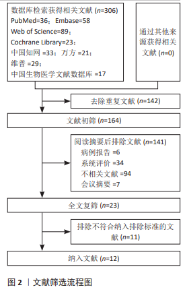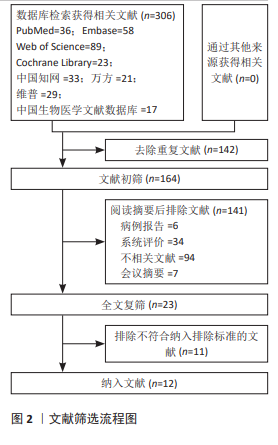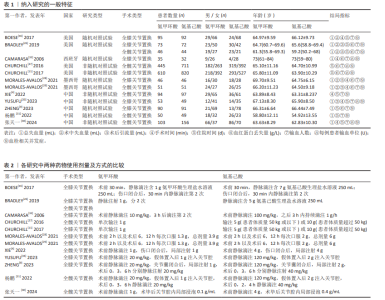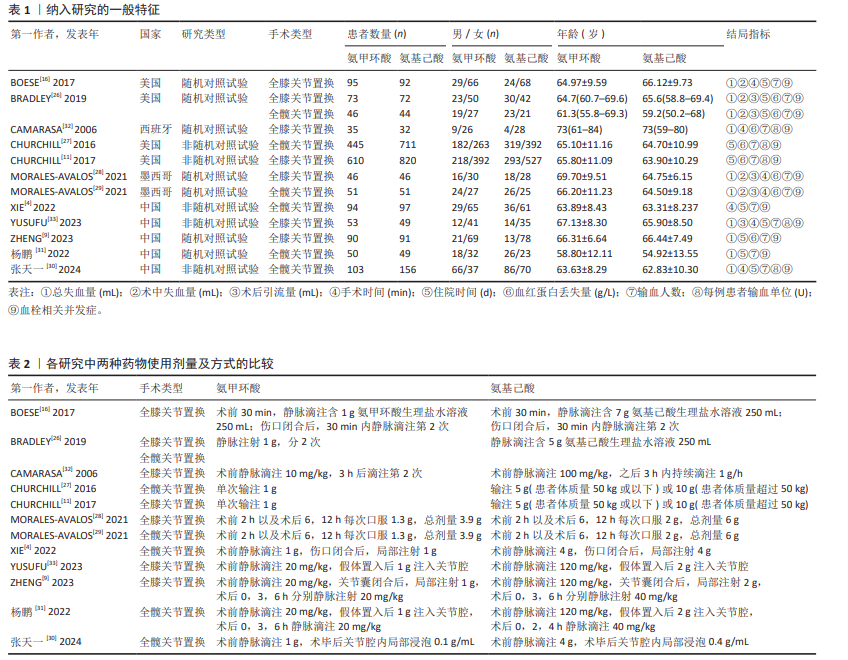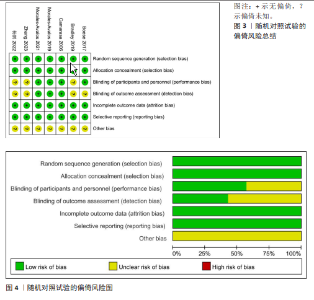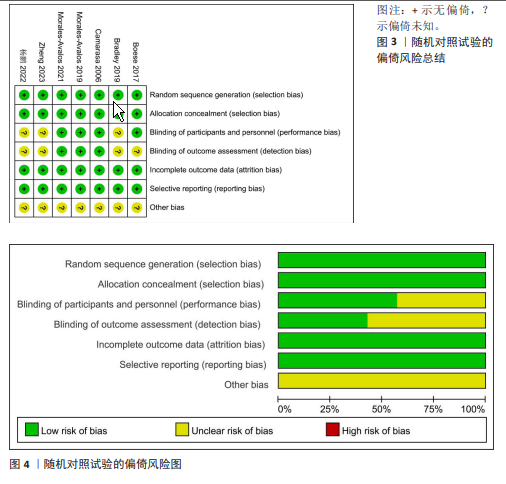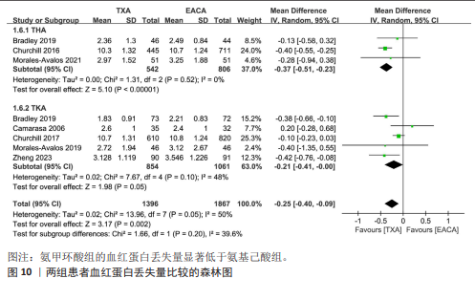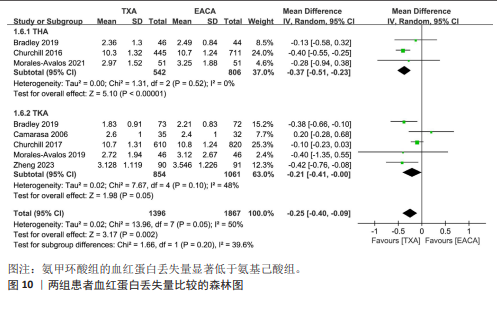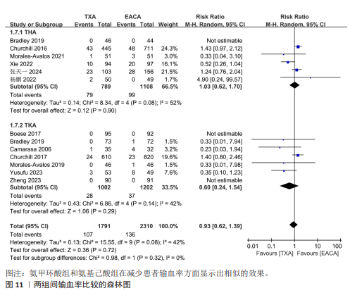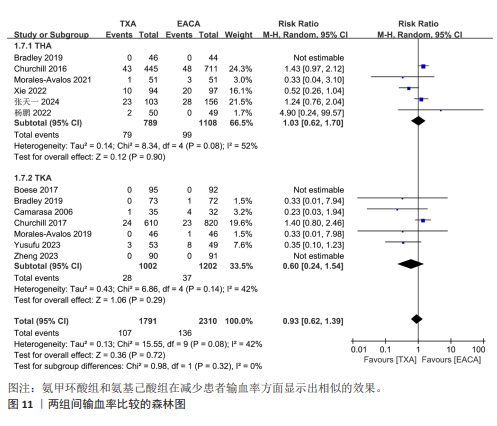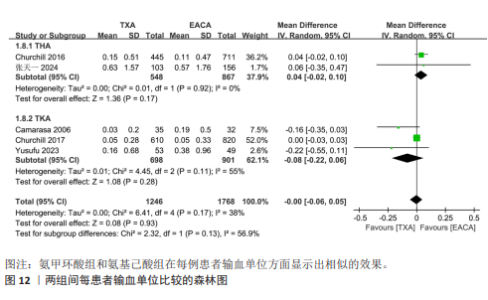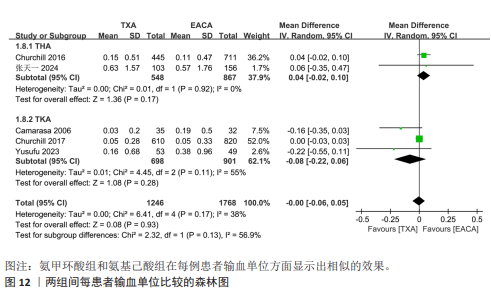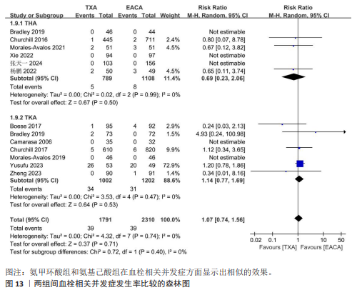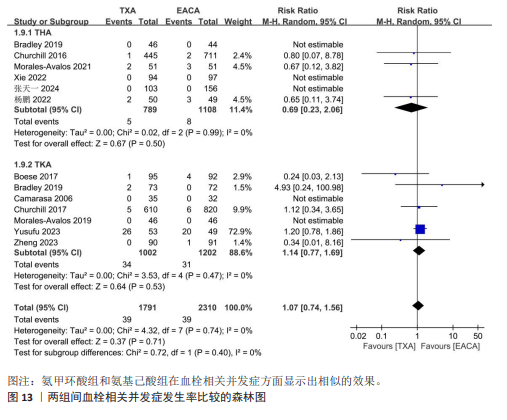Chinese Journal of Tissue Engineering Research ›› 2026, Vol. 30 ›› Issue (9): 2361-2369.doi: 10.12307/2026.587
Previous Articles Next Articles
Effectiveness and safety of tranexamic acid versus epsilon-aminocaproic acid in total hip and knee arthroplasties: a meta-analysis
He Yixiang1, Qiao Wanjia1, Wang Wenji1, 2
- 1First Clinical Medical College of Lanzhou University, Lanzhou 730000, Gansu Province, China; 2Department of Orthopedics, First Hospital of Lanzhou University, Lanzhou 730000, Gansu Province, China
-
Received:2024-12-02Accepted:2025-03-14Online:2026-03-28Published:2025-09-29 -
Contact:Wang Wenji, Professor, Chief physician, Doctoral supervisor, First Clinical Medical College of Lanzhou University, Lanzhou 730000, Gansu Province, China; Department of Orthopedics, First Hospital of Lanzhou University, Lanzhou 730000, Gansu Province, China -
About author:He Yixiang, Doctoral candidate, First Clinical Medical College of Lanzhou University, Lanzhou 730000, Gansu Province, China
CLC Number:
Cite this article
He Yixiang, Qiao Wanjia, Wang Wenji. Effectiveness and safety of tranexamic acid versus epsilon-aminocaproic acid in total hip and knee arthroplasties: a meta-analysis[J]. Chinese Journal of Tissue Engineering Research, 2026, 30(9): 2361-2369.
share this article
Add to citation manager EndNote|Reference Manager|ProCite|BibTeX|RefWorks
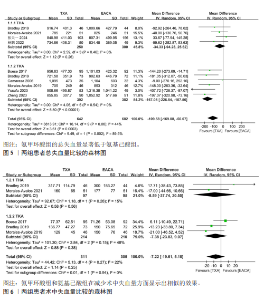
2.3 Meta分析结果 2.3.1 总失血量 共有9项研究提供了总失血量数据(氨甲环酸组642例,氨基己酸组682例)[9,16,26,28-33]。在全髋关节置换患者中,总失血量差异无显著性意义(MD=-34.33,95%CI:-94.28-25.62,P=0.26,I2=0%)。在全膝关节置换患者中,氨甲环酸组总失血量显著低于氨基己酸组(MD=-167.05,95%CI:-226.54至-107.56,P < 0.001,I2=0%)。森林图见图5。 2.3.2 术中失血量 共有4项研究提供了术中出血量数据(氨甲环酸组311例,氨基己酸组305例)[16,26,28-29]。结果显示,两种药物在全髋关节置换(MD=-8.59,95%CI:-37.74-20.55,P=0.56,I2=15%)和全膝关节置换(MD= -7.38,95%CI:-23.83-9.07,P=0.38,I2= 48%)减少术中失血量方面显示出相似的效果,差异无显著性意义。森林图见图6。"
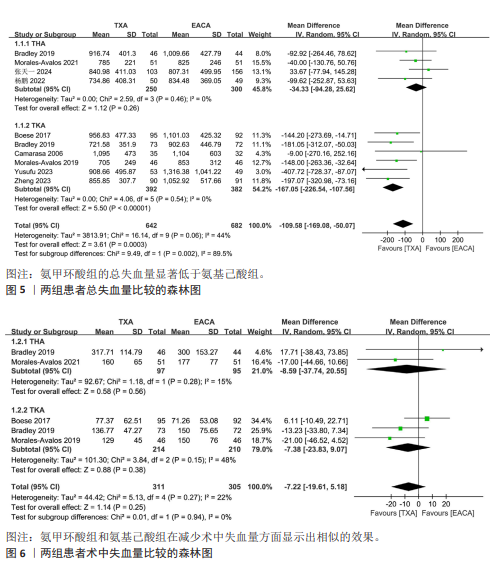
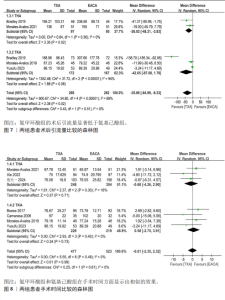
2.3.3 术后引流量 共有4项研究提供了术后引流量数据(氨甲环酸组269例,氨基己酸组262例)[26,28-29,33]。 在全髋关节置换患者中,氨甲环酸组术后引流量低于氨基己酸组(MD=-26.02,95%CI: -48.21至-3.83,P=0.02,I2=0%)。在全膝关节置换患者中,两组术后引流量相比差异无显著性意义(MD=-42.65,95%CI:-87.08-1.79,P=0.06,I2=94%)。森林图见图7。 2.3.4 手术时间 共有7项研究提供了手术时间数据(氨甲环酸组477例,氨基己酸组523例)[4,16,28-30,32-33]。 结果显示,全髋关节置换患者(MD=-0.68,95%CI:-4.26-2.90,P= 0.71,I2=16%)与全膝关节置换患者(MD=0.58,95%CI:-2.75-3.91,P=0.73,I2=0%)的手术时间相比差异均无显著性意义。森林图见图8。"
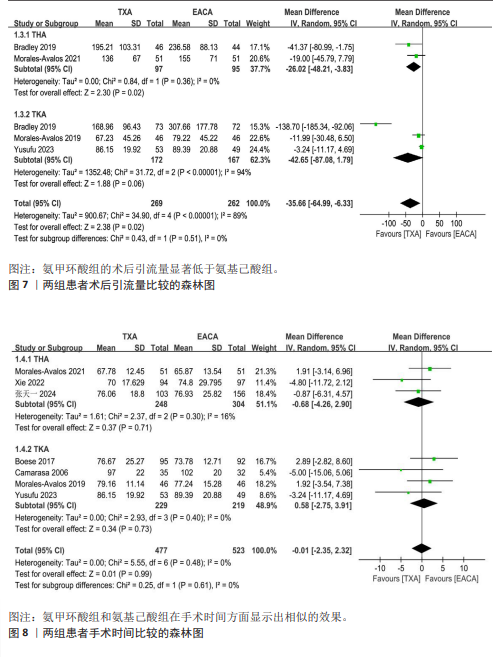
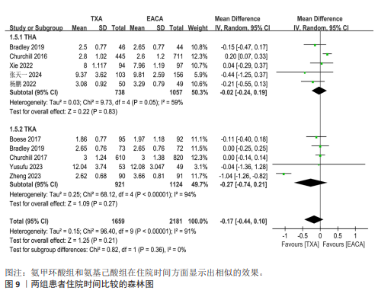
2.3.5 住院时间 共有9项研究提供了住院时间的数据(氨甲环酸组为1 659例,氨基己酸组为2 181例)[4,9,11,16,26-27,30-31,33]。结果显示,全髋关节置换患者住院时间(MD=-0.02,95%CI:-0.24-0.19,P=0.83,I2=59%)与全膝关节置换患者住院时间(MD=-0.27,95%CI:-0.74-0.21,P=0.27,I2=94%)相比差异无显著性意义。森林图见图9。 2.3.6 血红蛋白丢失量 共有7项研究提供了血红蛋白丢失量的数据(氨甲环酸组1 396例,氨基己酸组1 867例)[9,11,26-29,32]。结果显示,在全髋关节置换患者中,氨甲环酸组血红蛋白丢失量低于氨基己酸组(MD=-0.37,95%CI:-0.51至-0.23,P < 0.001,I2=0%)。在全膝关节置换患者中,两组血红蛋白丢失量差异无显著性意义(MD=-0.21,95%CI:-0.41至-0.00,P=0.05,I2=48%)。森林图见图10。"
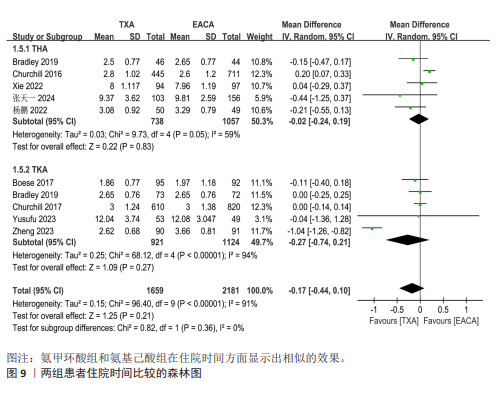
| [1] SUN W, ZHAO K, WANG Y, et al. Epidemiological Characteristics and Trends of Primary Hip Arthroplasty in Five Tertiary Hospitals: A Multicenter Retrospective Study. Orthop Surg. 2023;15(9):2267-2273. [2] HASLHOFER DJ, KRAML N, WINKLER PW, et al. Risk for total knee arthroplasty after tibial plateau fractures: a systematic review. Knee Surg Sports Traumatol Arthrosc. 2023; 31(11):5145-5153. [3] ZHANG AR, CHENG QH, YANG YZ, et al. Meta-analysis of outcomes after total knee arthroplasty in patients with rheumatoid arthritis and osteoarthritis. Asian J Surg. 2024;47(1):43-54. [4] XIE H, YANG YS, TIAN SM, et al. Tranexamic versus aminocaproic acids in patients with total hip arthroplasty: a retrospective study. BMC Musculoskelet Disord. 2022;23(1): 999. [5] 元宝华, 柳海平, 李兴勇, 等. 氨甲环酸在关节置换术和关节镜手术围术期中的应用现状[J]. 中国临床药理学杂志,2024, 40(7):1080-1084. [6] SLOAN M, PREMKUMAR A, SHETH NP. Projected Volume of Primary Total Joint Arthroplasty in the U.S., 2014 to 2030. J Bone Joint Surg Am. 2018;100(17): 1455-1460. [7] AGUILERA X, MARTíNEZ-ZAPATA MJ, HINAREJOS P, et al. Topical and intravenous tranexamic acid reduce blood loss compared to routine hemostasis in total knee arthroplasty: a multicenter, randomized, controlled trial. Arch Orthop Trauma Surg. 2015;135(7):1017-1025. [8] 李毅, 唐淼, 刘长征. 口服氨甲环酸对减少膝关节置换术后失血量的分析[J]. 实用骨科杂志,2020,26(5):460-463. [9] ZHENG C, MA J, XU J, et al. Combination of Intravenous and Intra-Articular Application of Tranexamic Acid and Epsilon-Aminocaproic Acid in Primary Total Knee Arthroplasty: A Prospective Randomized Controlled Trial. Orthop Surg. 2023;15(3): 687-694. [10] RIAZ O, AQIL A, ASMAR S, et al. Epsilon-aminocaproic acid versus tranexamic acid in total knee arthroplasty: a meta-analysis study. J Orthop Traumatol. 2019;20(1):28. [11] CHURCHILL JL, PUCA KE, MEYER E, et al. Comparing ε-Aminocaproic Acid and Tranexamic Acid in Reducing Postoperative Transfusions in Total Knee Arthroplasty. J Knee Surg. 2017;30(5):460-466. [12] HAN J, ZHANG XY, MU SY, et al. Tourniquet application in primary total knee arthroplasty for osteoarthritis: A systematic review and meta-analysis of randomized controlled trials. Front Surg. 2022;9: 994795. [13] DONG J, MIN S, HE KH, et al. Effects of the nontourniquet combined with controlled hypotension technique on pain and long-term prognosis in elderly patients after total knee arthroplasty: a randomized controlled study. J Anesth. 2019;33(5):587-593. [14] 樊华, 程晴灏, 张福康, 等. 气压止血带在初次膝关节置换术中的临床应用[J]. 国际骨科学杂志,2023,44(4):207-210. [15] DAUTERMAN L, KHAN N, TEBBE C, et al. Efficacy and safety of intraoperative controlled hypotension: a systematic review and meta-analysis of randomised trials. Br J Anaesth. 2024;133(5):940-954. [16] BOESE CK, CENTENO L, WALTERS RW. Blood Conservation Using Tranexamic Acid Is Not Superior to Epsilon-Aminocaproic Acid After Total Knee Arthroplasty. Journal of bone and joint surgery American volume. 2017; 99(19):1621‐1628. [17] LU J, MENG H, MENG Z, et al. Epsilon aminocaproic acid reduces blood transfusion and improves the coagulation test after pediatric open-heart surgery: a meta-analysis of 5 clinical trials. Int J Clin Exp Pathol. 2015;8(7):7978-7987. [18] RAGHUNATHAN K, CONNELLY NR, KANTER GJ. ε-Aminocaproic acid and clinical value in cardiac anesthesia. J Cardiothorac Vasc Anesth. 2011;25(1):16-19. [19] 张晋, 杨自权. 氨甲环酸和ε-氨基己酸在髋膝关节置换术中止血疗效的Meta分析[J]. 中国骨伤,2022,35(5):484-490. [20] 陈旺, 冯硕, 张羽, 等. 氨甲环酸和ε-氨基己酸减少全膝关节围置换期失血有效和安全性的Meta分析[J]. 中国组织工程研究,2021,25(15):2430-2436. [21] PAGE MJ, MCKENZIE JE, BOSSUYT PM, et al. The PRISMA 2020 statement: an updated guideline for reporting systematic reviews. Bmj. 2021;372:n71. [22] HIGGINS JP, ALTMAN DG, GøTZSCHE PC, et al. The Cochrane Collaboration’s tool for assessing risk of bias in randomised trials. Bmj. 2011;343:d5928. [23] STANG A. Critical evaluation of the Newcastle-Ottawa scale for the assessment of the quality of nonrandomized studies in meta-analyses. Eur J Epidemiol. 2010;25(9): 603-605. [24] SCHMIDT FL, OH IS, HAYES TL. Fixed- versus random-effects models in meta-analysis: model properties and an empirical comparison of differences in results. Br J Math Stat Psychol. 2009; 62(Pt 1): 97-128. [25] HIGGINS JP, THOMAS J, CHANDLER J, et al. Cochrane Handbook for Systematic Reviews of Interventions version 6.4 (updated August 2023). Cochrane. 2023. [26] BRADLEY KE, RYAN SP, PENROSE CT, et al. Tranexamic acid or epsilon-aminocaproic acid in total joint arthroplasty? A randomized controlled trial. Bone Joint J. 2019;101-b(9):1093-1099. [27] CHURCHILL JL, PUCA KE, MEYER ES, et al. Comparison of ε-Aminocaproic Acid and Tranexamic Acid in Reducing Postoperative Transfusions in Total Hip Arthroplasty. J Arthroplasty. 2016;31(12):2795-2799.e2791. [28] MORALES-AVALOS R, RAMOS-MORALES T, ESPINOZA-GALINDO AM, et al. First Comparative Study of the Effectiveness of the Use of Tranexamic Acid against ε-Aminocapróic Acid via the Oral Route for the Reduction of Postoperative Bleeding in TKA: A Clinical Trial. J Knee Surg. 2021; 34(4):383-405. [29] MORALES-AVALOS R, RAMOS-MORALES T, GARCíA-PEDRO JA, et al. Tranexamic acid versus aminocapróic acid in multiple doses via the oral route for the reduction of postoperative bleeding in total primary hip arthroplasty: a prospective, randomized, double-blind, controlled study. Blood coagulation & fibrinolysis. 2021;32(2): 132‐139. [30] 张天一, 李立新, 孔繁林, 等. 氨基己酸与氨甲环酸在全髋关节置换术中的临床疗效与输血成本比较[J]. 安徽医学,2024, 45(3):337-341. [31] 杨鹏, 马俊, 曾俊峰, 等. 氨基己酸与氨甲环酸用于全髋关节置换术的随机对照研究[J]. 中国矫形外科杂志,2022,30(3): 214-218. [32] CAMARASA MA, OLLÉ G, SERRA-PRAT M, et al. Efficacy of aminocaproic, tranexamic acids in the control of bleeding during total knee replacement: a randomized clinical trial. British journal of anaesthesia. 2006; 96(5):576‐582. [33] YUSUFU A, HAIBIER A, QIN Q, et al. Efficacy and safety of tranexamic acid and aminocaproic acid in perioperative period of total knee arthroplasty. Zhongguo Zuzhi Gongcheng Yanjiu. 2023;27(36):5812-5817. [34] KAPADIA BH, TORRE BB, ULLMAN N, et al. Reducing perioperative blood loss with antifibrinolytics and antifibrinolytic-like agents for patients undergoing total hip and total knee arthroplasty. J Orthop. 2019; 16(6):513-516. [35] JOO YB, KIM YM, AN BK, et al. Topical Tranexamic Acid Can Be Used Safely Even in High Risk Patients: Deep Vein Thrombosis Examination Using Routine Ultrasonography of 510 Patients. Medicina (Kaunas). 2022; 58(12):1750. [36] YANG YZ, CHENG QH, ZHANG AR, et al. Efficacy and safety of single- and double-dose intravenous tranexamic acid in hip and knee arthroplasty: a systematic review and meta-analysis. J Orthop Surg Res. 2023; 18(1):593. [37] KIMURA OS, FREITAS EH, DUARTE ME, et al. Tranexamic acid use in high-risk blood transfusion patients undergoing total hip replacement: a randomised controlled trial. Hip Int. 2021;31(4):456-464. [38] HOBBS JC, WELSBY IJ, GREEN CL, et al. Epsilon Aminocaproic Acid to Reduce Blood Loss and Transfusion After Total Hip and Total Knee Arthroplasty. J Arthroplasty. 2018;33(1):55-60. [39] TRIPATHY SK, RAO PB, NANDA SN, et al. Safety and efficacy of epsilon aminocaproic acid (EACA) as an antihemorrhagic drug in bilateral one stage total knee arthroplasty: A double-blind randomized controlled trial. Knee. 2020;27(1):229-234. [40] DUNCAN CM, GILLETTE BP, JACOB AK, et al. Venous thromboembolism and mortality associated with tranexamic acid use during total hip and knee arthroplasty. J Arthroplasty. 2015;30(2):272-276. [41] GOLEMBIEWSKI J. Antifibrinolytic Use in the Perioperative Setting: Aminocaproic Acid and Tranexamic Acid. J Perianesth Nurs. 2015;30(6):560-563. [42] WHITING DR, GILLETTE BP, DUNCAN C, et al. Preliminary results suggest tranexamic acid is safe and effective in arthroplasty patients with severe comorbidities. Clin Orthop Relat Res. 2014;472(1):66-72. [43] 邹春雨, 岳辰, 杨澜波, 等. 氨甲环酸于合并致静脉血栓栓塞事件形成高危并存疾病全膝置换的安全性和有效性[J].中华全科医学,2021,19(6):901-903. [44] HARPER RA, SUCHER MG, GIORDANI M, et al. Topically Applied Epsilon-Aminocaproic Acid Reduces Blood Loss and Length of Hospital Stay After Total Knee Arthroplasty. Orthopedics. 2017;40(6):e1044-e1049. [45] LIU WB, LI GS, SHEN P, et al. Comparison between epsilon-aminocaproic acid and tranexamic acid for total hip and knee arthroplasty: A meta-analysis. J Orthop Surg (Hong Kong). 2020;28(3): 2309499020959158. [46] LI J, GUO Y, LI M. Comparison of efficacy between tranexamic acid and epsilon-aminocaproic acid for total knee arthroplasty: A meta-analysis of randomized controlled trials. Medicine (Baltimore). 2023;102(47):e33876. [47] LIU Q, GENG P, SHI L, et al. Tranexamic acid versus aminocaproic acid for blood management after total knee and total hip arthroplasty: A systematic review and meta-analysis. Int J Surg. 2018;54(Pt A):105-112. |
| [1] | Zhang Anqi, Hua Haotian, Cai Tianyuan, Wang Zicheng, Meng Zhuo, Zhan Xiaoqian, Chen Guoqian . Pain after total knee arthroplasty: current status and trend analysis [J]. Chinese Journal of Tissue Engineering Research, 2026, 30(3): 795-804. |
| [2] | Zhou Jinhai, Li Jiangwei, Wang Xuquan, Zhuang Ying, Zhao Ying, Yang Yuyong, Wang Jiajia, Yang Yang, Zhou Shilian. Three-dimensional finite element analysis of anterior femoral notching during total knee arthroplasty at different bone strengths [J]. Chinese Journal of Tissue Engineering Research, 2025, 29(9): 1775-1782. |
| [3] | Su Dejun, Dong Wanpeng, Dong Yuefu, Zhang Jichao, Zhang Zhen. Design of asymmetric prosthesis and mechanical analysis of total knee arthroplasty [J]. Chinese Journal of Tissue Engineering Research, 2025, 29(3): 510-516. |
| [4] | Qi Junlong, Liu Junyi, He Yuzhou, Qiang Wei, Zhang Shiying, Liu Qiao, Zhu Hongda. Functionalized self-assembled micelles enhance effect of tranexamic acid in treatment of cutaneous hyperpigmentation [J]. Chinese Journal of Tissue Engineering Research, 2025, 29(28): 6061-6069. |
| [5] | Wang Yijun, Zheng Kai, Zhang Lianfang, Zhu Feng, Zhang Weicheng, Li Rongqun, Zhou Jun, Xu Yaozeng. Navigation-assisted total knee arthroplasty using functional alignment restores constitutional alignment and joint line obliquity [J]. Chinese Journal of Tissue Engineering Research, 2025, 29(27): 5810-5818. |
| [6] | Zhang Yilong, Wu Wanling, Yang Wenwu, Wu Hongtao, Liu Wengang, He Minyi, Zhao Chuanxi. Correlation between preoperative knee extensor and flexor muscle strength and postoperative gait function in total knee arthroplasty [J]. Chinese Journal of Tissue Engineering Research, 2025, 29(27): 5819-5825. |
| [7] | Ding Yuan, Gong Jianbao, Zhang Jie, Qiao Yuan, Xu Wenlong. Characteristic analysis of isometric muscle strength of knee joint in patients after unicompartmental knee arthroplasty [J]. Chinese Journal of Tissue Engineering Research, 2025, 29(27): 5833-5838. |
| [8] | Wang Jun, Zhang Hui, Li Zhengyuan, Hao Lin, Chen Shenghong, Yin Zongsheng. Assessment on initial effectiveness of a novel local infiltration anesthesia in total knee arthroplasty [J]. Chinese Journal of Tissue Engineering Research, 2025, 29(27): 5839-5844. |
| [9] | Pan Xian, Zhang Yuanjin, Zhang Guofu, Li Jun, Liu Bingxia, Zhou Dingkang, Sun Farui. Debridement, antibiotics, and implant retention combined with replacement of assembled components in treatment of acute prosthetic joint infection after total hip arthroplasty [J]. Chinese Journal of Tissue Engineering Research, 2025, 29(21): 4499-4505. |
| [10] | Li Yuanfeng, Ye Pufeng, Pan Guifeng, Mai Zhenjiang. Dose-effect relationship between dexmedetomidine and ropivacaine during pericapsular nerve group block in elderly patients undergoing total hip arthroplasty [J]. Chinese Journal of Tissue Engineering Research, 2025, 29(21): 4514-4520. |
| [11] | Wang Yuning, Zhu Haotian, Liu Kang, Ding Huanwen, Yan Han. Comparison of short-term therapeutic effects between digital precision total knee arthroplasty and traditional methods [J]. Chinese Journal of Tissue Engineering Research, 2025, 29(21): 4521-4528. |
| [12] | Xu Minglan, Hu Xiaoxue, Shen Jun, Xiang Zheng, Zhang Chengbo, Xiao Lianbo. Opposing needling acupuncture combined with preemptive analgesia in treatment of pain after initial unilateral total knee arthroplasty [J]. Chinese Journal of Tissue Engineering Research, 2025, 29(21): 4529-4536. |
| [13] | Zheng Zewei, Ye Kaijing, Zhang Kuo, Zhao Qinghua, Chen Xiutian, Jiang Yulai, Yi Yanzi, Zhang Qingwen. Hypoproteinemia after total hip arthroplasty: risk factors and nomogram prediction model establishment [J]. Chinese Journal of Tissue Engineering Research, 2025, 29(15): 3147-3152. |
| [14] | Pan Hao, Yang Meng, Liu Guoqiang. Timing of total knee arthroplasty with tourniquet under navigation system: a single-center, retrospective analysis [J]. Chinese Journal of Tissue Engineering Research, 2025, 29(15): 3159-3164. |
| [15] | Min Meipeng, Wu Jin, URBA RAFI, Zhang Wenjie, Gao Jia, Wang Yunhua, He Bin, Fan Lei. Role and significance of artificial intelligence preoperative planning in total hip arthroplasty [J]. Chinese Journal of Tissue Engineering Research, 2024, 28(9): 1372-1377. |
| Viewed | ||||||
|
Full text |
|
|||||
|
Abstract |
|
|||||
